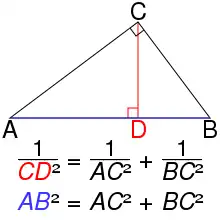Inverse Pythagorean theorem
In geometry, the inverse Pythagorean theorem (also known as the reciprocal Pythagorean theorem[1] or the upside down Pythagorean theorem[2]) is as follows:[3]
- Let A, B be the endpoints of the hypotenuse of a right triangle △ABC. Let D be the foot of a perpendicular dropped from C, the vertex of the right angle, to the hypotenuse. Then

| Base Pytha- gorean triple | AC | BC | CD | AB | |
|---|---|---|---|---|---|
| (3, 4, 5) | 20 = 4× 5 | 15 = 3× 5 | 12 = 3× 4 | 25 = 52 | |
| (5, 12, 13) | 156 = 12×13 | 65 = 5×13 | 60 = 5×12 | 169 = 132 | |
| (8, 15, 17) | 255 = 15×17 | 136 = 8×17 | 120 = 8×15 | 289 = 172 | |
| (7, 24, 25) | 600 = 24×25 | 175 = 7×25 | 168 = 7×24 | 625 = 252 | |
| (20, 21, 29) | 609 = 21×29 | 580 = 20×29 | 420 = 20×21 | 841 = 292 | |
| All positive integer primitive inverse-Pythagorean triples having up to three digits, with the hypotenuse for comparison | |||||
This theorem should not be confused with proposition 48 in book 1 of Euclid's Elements, the converse of the Pythagorean theorem, which states that if the square on one side of a triangle is equal to the sum of the squares on the other two sides then the other two sides contain a right angle.
Proof
The area of triangle △ABC can be expressed in terms of either AC and BC, or AB and CD:
given CD > 0, AC > 0 and BC > 0.
Using the Pythagorean theorem,
as above.
Special case of the cruciform curve
The cruciform curve or cross curve is a quartic plane curve given by the equation
where the two parameters determining the shape of the curve, a and b are each CD.
Substituting x with AC and y with BC gives
Inverse-Pythagorean triples can be generated using integer parameters t and u as follows.[4]
Application
If two identical lamps are placed at A and B, the theorem and the inverse-square law imply that the light intensity at C is the same as when a single lamp is placed at D.
See also
- Geometric mean theorem – Theorem about right triangles
- Pythagorean theorem – Relation between sides of a right triangle
References
- R. B. Nelsen, Proof Without Words: A Reciprocal Pythagorean Theorem, Mathematics Magazine, 82, December 2009, p. 370
- The upside-down Pythagorean theorem, Jennifer Richinick, The Mathematical Gazette, Vol. 92, No. 524 (July 2008), pp. 313-316
- Johan Wästlund, "Summing inverse squares by euclidean geometry", http://www.math.chalmers.se/~wastlund/Cosmic.pdf, pp. 4–5.
- "Diophantine equation of three variables".